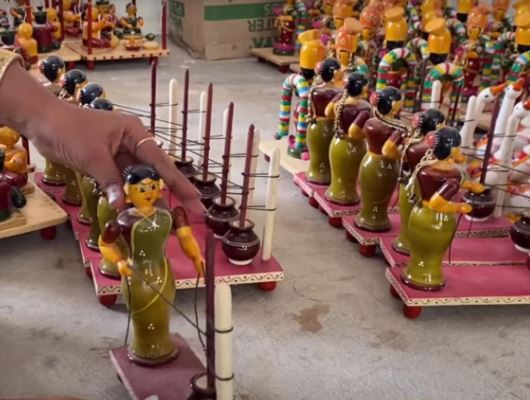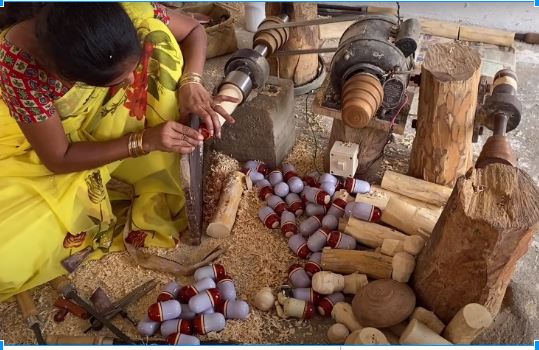Have you heard of Lakka pidithalu or LakkaBommalu; A Traditional Art Form from Etikoppaka, a small village located about 70 km from Visakhapatnam situated close to Elamanchili. This article delves into the heritage of Etikoppaka Toys, explores the path to their future, and sheds light on the challenges that need to be overcome by the skillful craftsman that carried the legacy for many generations.

Lakka Bommalu, Toys from Etikoppaka on display
Etikoppaka toys, a cherished historical art form, have embarked on a journey of revival, blending tradition and innovation. Prime Minister Narendra Modi’s vision of making India a global hub for toy production, alongside his ‘vocal for local toys’ initiative, has propelled renowned wooden toymaker C.V. Raju from Etikoppaka into the limelight. However, as we delve deeper, significant challenges continue to hound the industry.
The Eternal Craft of Etikoppaka Toys:
For over 400 years, the artisans of Etikoppaka have dedicated themselves to crafting exquisite wooden toys. What once started as the creation of simple bowls and boxes for household use gradually evolved into a cultural phenomenon that captivated the hearts of local kings, zamindars, and landlords. The turning point arrived when these skilled craftsmen ventured into the realm of toy making, introducing the iconic Lakkapidathalu kitchen set. With its vibrant colors and natural dyes which are safe as they are derived directly from seeds, lacquer, and leaves, the Etikoppaka toy industry blossomed into a rich and beautiful tradition.
The Resilience of Etikoppaka Artisans:
Despite numerous hurdles, the artisans of Etikoppaka have displayed unwavering resilience. The COVID-19 pandemic dealt a severe blow to the industry, forcing shops to shut down and halting both online and offline sales. The absence of government assistance left low-wage workers reliant on NGOs for their daily sustenance. However, the ‘vocal for local’ call made by Prime Minister Modi breathed fresh life into the industry. Local toy makers have witnessed a significant surge in orders, with an increasing preference for indigenous toys over those manufactured in China.
A Glorious Renaissance:
Renowned toy maker S. Chinnayachari, with nearly three decades in the industry, attests to the positive impact of the ‘Mann Ki Baat’ episode and the ‘vocal for local’ campaign. Notably, the G.I tag obtained in 2017 further amplified global recognition for Etikoppaka toys, benefiting exporters substantially. Presently, people across different states are actively searching for these unique toys online. The surge in demand has led to bulk orders for parties, weddings, and various functions, where Etikoppaka toys now serve as cherished return gifts.
Vibrant Varieties and Economic Empowerment:

A skilled worker woman from Etikoppaka village near Visakhapatnam crafting the wooden pieces skillfully into beautiful toys
Among the fascinating array of Etikoppaka toys, the ‘Kum-Kum-Barini,’ ‘Sri Ram Pattabhishekam,’ ‘Bride and Bridegroom,’ and ‘Sri Venkateswara Swamy’ figures emerge as preferred choices for return gifts. Moreover, the Etikoppaka toy industry has empowered many women in the village. Toy maker S. Chinnayachari, who once began as a small-wage artisan, now provides employment to approximately 140 women. The industry enables them to showcase their creativity, with artists like K. Lakshmi becoming experts in painting these delicate wooden treasures.
Challenges on the Path Ahead:
While the Etikoppaka toy industry registers progress, challenges loom large on the horizon. Artisans currently grapple with a scarcity of ‘Ankud’ wood, a vital material for crafting these toys. Rising prices of dyes, increased transportation costs, and labor charges further burden the artisans. The government’s support is crucial in reviving this industry, with promises of providing Ankud wood yet to be fulfilled. Assistance in the form of subsidies, workshops on packing material for exports, and expert-led seminars could pave the way for sustainable growth.
Preserving Tradition, Ensuring a Bright Future:
Even as the Etikoppaka toy industry enjoys a revival, concerns about its future persist. The absence of young individuals embracing ancestral occupations poses a significant threat to the survival of this age-old craft. Many from the younger generation have migrated to metropolitan cities in pursuit of alternate employment opportunities. To secure the future of Etikoppaka toys, exhibitions, bazaars, and melas held across different cities will play a crucial role in promoting and preserving this cherished heritage.
Conclusion:
The journey of Etikoppaka toys is a testament to the remarkable blend of tradition and innovation. Prime Minister Narendra Modi’s ‘vocal for local’ campaign has propelled this unique craft into the global spotlight. However, challenges, such as scarcity of raw materials and rising costs, continue to impact this industry. With the government’s support and initiatives, including subsidies and awareness programs, the heritage of Etikoppaka toys can thrive, thereby ensuring a vibrant path to the future while preserving its rich cultural legacy. Lets hope they survive the tide and carry it forward into our next generations.